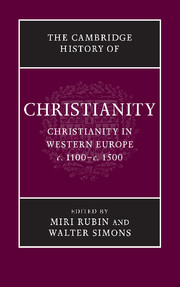Book contents
- Frontmatter
- Introduction
- PART I INSTITUTIONS AND CHANGE: 1100–1200
- PART II FORGING A CHRISTIAN WORLD, 1200–1300
- PART III THE ERECTION OF BOUNDARIES
- 10 Christians and Jews
- 11 Christendom and Islam
- 12 Christians and heretics
- 13 Women and men
- 14 Heaven, hell and purgatory: 1100–1500
- PART IV SHAPES OF A CHRISTIAN WORLD
- PART V CHRISTIAN LIFE IN MOVEMENT
- PART VI THE CHALLENGES TO A CHRISTIAN SOCIETY
- PART VII REFORM AND RENEWAL
- Select bibliography
- Index
- Map 1 Western Europe c. 1100 – c. 1500
- Map 2 Universities of Europe
- References
14 - Heaven, hell and purgatory: 1100–1500
from PART III - THE ERECTION OF BOUNDARIES
Published online by Cambridge University Press: 28 March 2010
- Frontmatter
- Introduction
- PART I INSTITUTIONS AND CHANGE: 1100–1200
- PART II FORGING A CHRISTIAN WORLD, 1200–1300
- PART III THE ERECTION OF BOUNDARIES
- 10 Christians and Jews
- 11 Christendom and Islam
- 12 Christians and heretics
- 13 Women and men
- 14 Heaven, hell and purgatory: 1100–1500
- PART IV SHAPES OF A CHRISTIAN WORLD
- PART V CHRISTIAN LIFE IN MOVEMENT
- PART VI THE CHALLENGES TO A CHRISTIAN SOCIETY
- PART VII REFORM AND RENEWAL
- Select bibliography
- Index
- Map 1 Western Europe c. 1100 – c. 1500
- Map 2 Universities of Europe
- References
Summary
This chapter’s story unfolds on many levels: most profoundly, in the individual conscience. Far from existing alone, however, personal feelings about the afterlife fit in a web of societal relationships. Heaven, hell and purgatory certainly involve the dead, but dead souls were not completely absent from earth and continued to haunt their families. As in Roman times, the family included its departed parents and ancestors. Medieval Europeans expressed clan loyalty through ‘suffrages’, actions dedicated to the dead. Charters recording gifts to churches show donors acted to benefit their own souls and those of their predecessors. Tales relate the visits from purgatory or hell requesting that heirs pay debts or resolve other unfinished business. Revenants also appear from heaven to encourage the pusillanimous. Thus, however pious the language, many charitable actions also comprised a personal interest: a cleansing of conscience, earning of merit, removal of guilt. Gifts to churches were also gifts to ecclesiastics; pious donations created alliances with people influential in the world.
Religious authorities, who were often political powers too, functioned at all levels, from the papacy to the parish, and also shaped personal attitudes towards heaven and hell. Popes and councils intervened with dogmatic definitions and the prosecution of heretics. Theologians articulated reasons for individual doctrinal provisions and offered their conclusions to confessors and preachers in manuals that began to circulate in Latin around 1200, in the vernacular around 1300, and in print around 1450.
Keywords
- Type
- Chapter
- Information
- The Cambridge History of Christianity , pp. 200 - 216Publisher: Cambridge University PressPrint publication year: 2009
References
- 1
- Cited by



